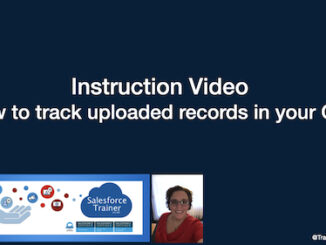Effective account and contact management form the foundation of successful customer relationships. Salesforce Sales Cloud offers automation features to optimize account and contact management for businesses. In this blog, we will dive into account and contact management automation and explore its specific functionalities, benefits, and potential challenges. By gaining a comprehensive understanding of account and contact management automation in Salesforce, businesses can drive improved customer insights, enhanced satisfaction, and increased Salesforce adoption within their organizations.
Centralized Customer Information and Data Automation:
Salesforce enables organizations to centralize and automate the management of customer information, providing a single source of truth for account and contact data. This automation eliminates data silos, improves data accuracy, and facilitates a holistic view of customer interactions.
Functionalities:
- Account and contact record automation: Salesforce automates the creation and updating of account and contact records through various integration methods, such as data imports, API integrations, or web forms.
- Data validation and cleansing: Automation features can be utilized to implement data validation rules, ensuring data accuracy and completeness. Data cleansing tools can automatically identify and correct data inconsistencies or duplicates.
Benefits:
- Improved customer insights: Centralizing customer data enables organizations to gain a comprehensive view of each account and contact, facilitating deeper understanding of customer needs, preferences, and behaviors.
- Enhanced customer satisfaction: Automation ensures that customer information is up to date, enabling sales representatives to deliver personalized experiences and timely responses to customer inquiries or requests.
- Streamlined sales cycles: Access to accurate and complete customer data reduces the time spent searching for information, enabling sales teams to focus on building relationships and advancing sales opportunities.
Challenges:
- Data integration and migration: Integrating customer data from multiple sources or migrating data from legacy systems can be complex. Organizations must plan and execute data integration and migration strategies carefully to ensure a smooth transition.
- Data governance and maintenance: Establishing data governance processes, such as data ownership, data quality measures, and regular data maintenance, is crucial to maintain the integrity of customer data.
Relationship and Interaction Management Automation:
Salesforce offers automation features that enable organizations to track and manage customer interactions, ensuring consistent and meaningful engagement throughout the customer journey.
Functionalities:
- Activity tracking and logging: Salesforce can be used to capture and log customer interactions, such as emails, calls, meetings, or social media engagements, providing a comprehensive history of customer interactions.
- Task and activity automation: Automation features can be utilized to create and assign tasks or activities related to accounts or contacts, ensuring timely follow-ups, reminders, or escalations.
Benefits:
- Comprehensive customer engagement history: Automation ensures that all customer interactions are recorded and easily accessible, providing a historical record of engagements for sales teams to reference and analyze.
- Proactive customer management: Automated tasks and reminders help sales representatives stay on top of important customer engagements, ensuring timely follow-ups and proactive relationship management.
- Consistent and personalized customer experiences: Access to interaction history enables sales representatives to deliver personalized and contextual experiences, strengthening customer relationships and loyalty.
Challenges:
- Data privacy and compliance: Automation features must adhere to data privacy regulations and organizational policies to ensure the protection of customer information.
- Managing data overload: Automation can generate a significant amount of data. Organizations must establish processes and tools to filter and prioritize customer interactions, ensuring that sales representatives focus on meaningful engagements.
Cross-Selling and Upselling Automation:
Salesforce automation features empower organizations to identify and capitalize on cross-selling and upselling opportunities by automating the identification, tracking, and nurturing of these opportunities within existing accounts.
Functionalities:
- Opportunity identification and tracking: Automation can be used to identify potential cross-selling or upselling opportunities based on predefined criteria, such as customer purchase history, product usage, or predictive analytics.
- Automated nurturing and personalized offers: Automation enables organizations to deliver targeted content, recommendations, or offers to customers based on their specific needs and preferences, increasing the chances of cross-selling or upselling success.
Benefits:
- Increased revenue generation: Automation helps organizations identify and pursue additional sales opportunities within existing accounts, maximizing revenue potential and customer lifetime value.
- Customer-centric approach: Automation allows organizations to deliver personalized recommendations and offers to customers, demonstrating a deep understanding of their needs and fostering a customer-centric approach.
- Streamlined sales processes: Automating cross-selling and upselling activities reduces manual effort and streamlines the sales cycle, enabling sales representatives to focus on value-added activities.
Challenges:
- Data accuracy and segmentation: Effective cross-selling and upselling automation rely on accurate customer data and appropriate segmentation criteria. Organizations must ensure data accuracy and regularly update segmentation rules to drive successful automation.
- Balancing automation and personalization: While automation streamlines cross-selling and upselling activities, it is essential to maintain a balance between automation and personalization. Organizations should deliver personalized offers and recommendations while avoiding generic or irrelevant communications.
By leveraging the benefits of centralized customer information and data automation, relationship and interaction management automation, and cross-selling and upselling automation, organizations can drive increased customer insights, enhanced satisfaction, and efficient sales cycles.
Account and contact management automation in Salesforce Sales Cloud offers businesses a comprehensive set of tools to optimize customer relationships, improve engagement, and capitalize on revenue opportunities.
This was the next post in a series about exploring key Sales Cloud Automation features for Businesses. The full list of past and upcoming topics in this series:
– Lead Management Automation
– Opportunity Management Automation
– Unleash Customer Relationships – Account and Contact Management Automation
– Streamlining Sales Excellence – Sales Process Automation
– Streamline decision making with Approval Automation
– Powering Productivity Email Automation and Integration
– Exploring Sales Forecasting Automation
– Exploring Territory Management Automation
– Navigating Salesforce Adoption Challenges
– Unlocking Synergy: Integration with External Systems
– Unleash Sales Potential Sales Performance and Analytics Automation





Be the first to comment